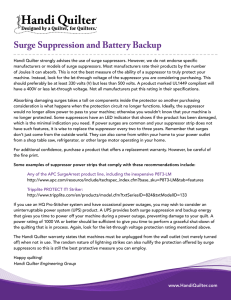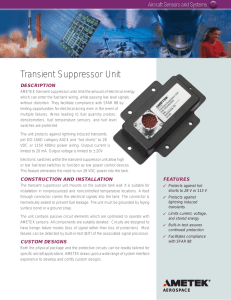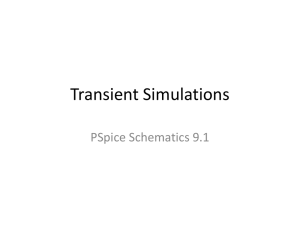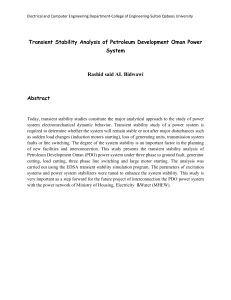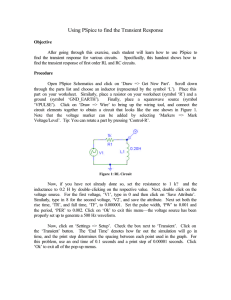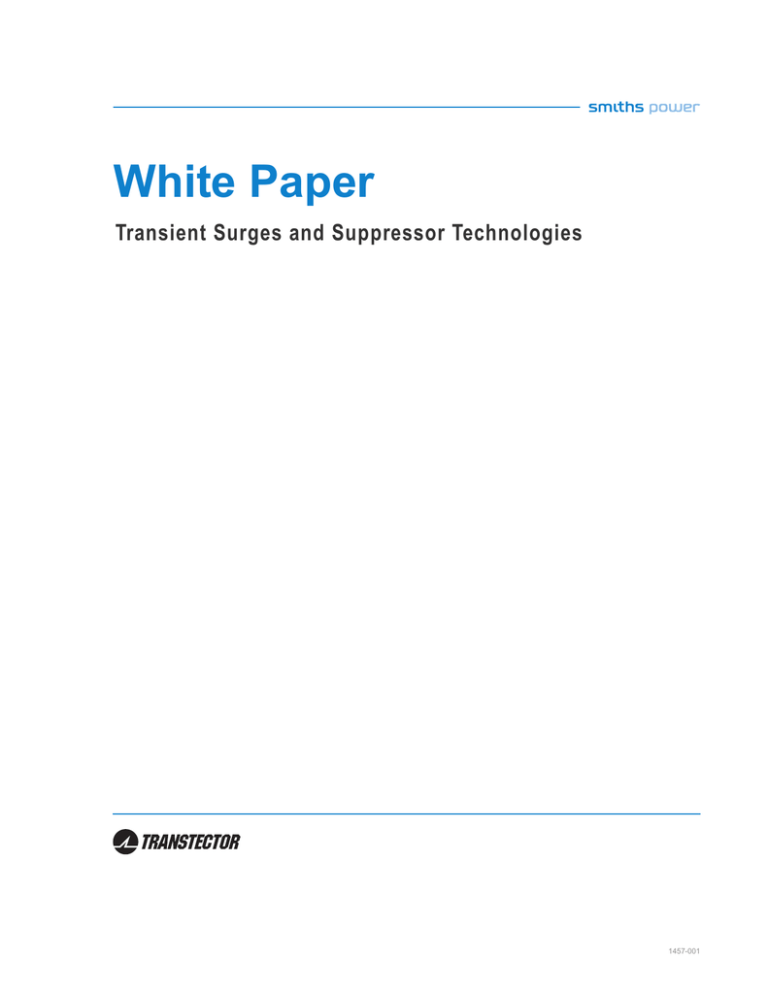
White Paper
Transient Surges and Suppressor Technologies
1457-001
White Paper | Transient Surges and Suppressor Technologies
Transient Surges and Suppressor Technologies
Metal Oxide Varistor (MOV) versus Silicon Avalanche Suppressor Diode (SASD)
Designs Discussion
The sole function of a quality surge suppressor is to protect sensitive electronic equipment from transient
overvoltages that are present on AC power circuits. It is irrelevant whether these overvoltages are
generated by lightning activity or are induced upon the AC power lines by utility grid switching, power factor
correction actions, power cycling of inductive loads, or from other sources. A quality surge suppressor
must limit transient overvoltages to values that do not surpass the AC sine wave peak by more than 30%
as it initially absorbs intense amounts of transient energy. The suppressor must immediately respond to
transients before they reach their uppermost voltage values. Suppressor performance should not deviate
or degrade with use when called upon to divert extreme levels of transient current.
Transient surges are differentiated by their duration, frequency and amplitude. The surge suppression
industry has adopted IEEE Power Engineering Society’s IEEE C62.41-2002 document, titled IEEE
RECOMMENDED PRACTICE ON SURGE VOLTAGES IN LOW-VOLTAGE AC POWER CIRCUITS, as
the standard for categorizing transients and the associated waveforms used to test suppressor effcacy.
This guide defnes several varied voltage and current waveforms that occur in the electrical distribution
environment. The most frequently referenced IEEE waveform is the combination wave. The combination
wave is characterized by short duration, high-frequency short-circuit 8/20μs and open-circuit 1.2/50μs
current and voltage waveforms. It is used to simulate lightning-induced transient activity. Longer duration,
lower frequency, higher energy 10/1000μs voltage and current test impulses (also detailed within the same
IEEE documentation) are recommended to simulate transient activity originating from other sources. For
testing, actual voltage and current values are selected in reference to where the surge suppressor is
intended for use. Surge suppressors intended for use at any location on the distribution system will be
subjected to long duration waveforms and should be tested to withstand these conditions, regardless of
their suppression technology. Figure 1 illustrates the combination waveforms.
When these combination waveforms are
utilized to test surge suppressors, the generator
voltage is adjusted to an open circuit voltage
(See Figure 1). It rises to this value within
1.2 microseconds. The voltage decays to 50
percent of that value after 50 microseconds.
Short circuit transient current pulses reach
their maximum value in 8 microseconds and
decay to their half-point after 20 microseconds.
The combination wave provides a starting
point to analyze a suppressor’s performance
characteristics in reference to voltage
protection levels (VPL) and power dissipating
capabilities.
Unfortunately, short duration test pulses do
not propagate far enough into an electrical
distribution system to give the suppressor user
a clear idea of how the suppressor will perform
in the real world. Transients that are generated
by grid switching
Figure 1
Because this generation has an internal impedance of 20Ω. The
peak current value will be 3000A. The suppressor is connected to
the generator for testing.
power cycling of inductive and capacitive loads and other sources cause suppressors to activate.
This transient activity is typically characterized by lower frequency (1 kHz) 10/1000μs duration
waveforms. The laboratory waveforms utilized to simulate this transient activity are shown in
Figure 2.
The physical properties of the electrical distribution system limit how far lightning-induced, or other
short duration, transient surges are able to travel. Extremely high voltage transients are required to
drive high voltage lightning surge current far into a facility. Transient voltages are limited (to typically
6000V because of air gap protection or insulation breakdown) at the meter base, preventing surge
currents from propagating far into the building. However, most transients originate from sources other
than lightning and are much more likely to travel longer distances throughout the AC power system.
These transient surges are more threatening to electrical loads because they are not diminished over
shorter distances, unlike lightning-induced impulses. In fact, lower level surges (below 6000V) actually
force more current into a system because the transients pass under the radar of the air gap.
Suppressors intended to protect at specificpoints along the electrical distribution system must be
selected in accordance with their physical location. Higher energy dissipating products must be used
at main distribution points as compared to sub panels or electrical outlets. Suppressors intended to
protect at a low exposure main or sub-panel locations inside any facility rarely need to be designed
to suppress more than 3000 amps of transient current. By design, meter base gaps allow for extreme
voltages to dissipate before they reach the distribution panel. Those outdoor transients might otherwise
pose a threat to the facility’s electrical distribution system. Figure 3 illustrates that high level voltages (in
excess of 6000V) are required to drive surge currents that exceed 5000 amps a distance farther than
10 meters into an electrical distribution system.
It is very important that a surge suppressor
be capable of suppressing short duration
impulses, resembling and including those
generated by lightning activity. It is equally, if not
more important, for a suppressor to be able to
sustain suppression functions and divert current
effectively when called upon to suppress longer
duration transients. Suppressors intended to
protect at branch panels or electrical outlets will
be called upon to suppress these transients more
frequently than those that are lightning-induced.
Surge suppressors should be tested to both
long and short duration laboratory waveforms to
confirm these suppression requirements.
Manufacturers utilize numerous technologies
for suppressor components. These include
selenium, gas tubes, metal oxide varistors
(MOVs), silicon avalanche suppressor diodes
(SASDs). However, most suppressors utilize
MOVs or SASDs or combinations of the two.
It is important to discuss the advantages
and disadvantages of the two most common
suppression technologies.
Figure 2
Figure 3
3
© Smiths Power 2013. All Rights Reserved.
White Paper | Transient Surges and Suppressor Technologies
Metal Oxide Varistors (MOVs)
MOVs are non-linear variable resistors with semi conductor properties that were originally designed
to protect electrical motor windings against wiring insulation breakdowns. There are two advantages
associated with MOVs in regard to surge suppressors. They are inexpensive and they divert reasonably
high values of transient current. MOVs are typically constructed with zinc oxide, which has non-linear
resistive characteristics. (The term non-linear is used to defne any device with resistive characteristics
that change as a function of the induced current. The equation takes the form of R=aI-b, where a and
b are constants and R will be a curved line.) The zinc oxide particles are compressed under very high
pressure to form various sized discs. To complete the varistor, electrical leads are bonded to the discs
and covered with an insulating material.
When transient currents are introduced to an electrical system, the MOV shunts the current away from
loads. As a varistor conducts transient current its internal resistance increases. Unfortunately, its nonlinear resistive characteristics prevent symmetrical resistance shifts equal to supplied current deviations.
The voltage drop across the MOV increases drastically as the varistor conducts high current values.
Numerous drawbacks become apparent as MOV based suppressors are utilized to protect sensitive
electronic circuitry:
1) An MOV based suppressor device cannot maintain a stable VPL as it conducts increasing current
values. As the device conducts increasing levels of transient current, it cannot limit transient overvoltages
to a value of less than 30% excess of the normal AC sine wave peak.
Figure 4 illustrates this inadequacy. Note that the curve representing the MOV’s suppression response
climbs steeply as it conducts longer duration transient current. The curve representing the suppression
response of the SASD shows that it does not suffer from the same drawbacks. Some MOV based
suppressor product specificationsboast extremely high surge current capacities (of up to 300,000 amps)
without reporting the VPL. These large figuressound impressive; however, this practice is misleading and
often meaningless. As depicted in Figure 5, the individual MOV components are frequently rated with a
reasonably high peak surge current rating. If a product utilizes multiple MOVs connected in parallel, some
manufacturers will add the current ratings of the individual MOV components together and report the
Figure 4
Figure 5
sum as an impressively high total value surge current capacity. This sum method is inaccurate because
it is impossible to coordinate simultaneous conduction of multiple MOVs that have varying component
tolerances and degradation cycles. It is like saying that a set of tires for your car will travel 200,000 miles
because each of the four tires is a 50,000 mile radial.
In addition, it remains diffcult to determine true VPL at the maximum rated surge current value. A device
constructed with larger MOVs can be useless to protect electronic equipment. Although the component
may be capable of suppressing much greater current values, it is very likely that the VPL will be too high
to protect electronic equipment.
2) MOVs degrade with use. Most MOV manufacturers warn users that the component is considered
failed after its initial VPL has moved +/- 10% from its original value. The MOVs conduct current through
paths of zinc oxide particles. After they conduct surge current, these particles change and their resistive
characteristics are weakened. This degradation cycle becomes more profound when the MOV conducts
more frequently or conducts higher current values. Although larger MOVs are more robust, they are
plagued by the same problems.
Figure 6 compares the single pulse life expectancy of 20 mm to 32 mm MOVs. Note that the 20mm
MOV can withstand 1,000 500A 8/20μs current pulses and will self-sacrificewhen it suppresses a single
6,500A 8/20μs transient current pulse. However, its surge current capacity decreases significantlyas it
is subjected to longer duration 10/1000μs transient current pulses. The 20mm MOV can be expected to
fail when subjected to 1,000 40A 10/1000μs current pulses or a single 200A 10/1000μs transient current
pulse.
The 32mm MOV is slightly more robust. It can handle one 20,000A or 1,000 900A 8/20μs current pulses
but no more than one 450A 10/1000μs current pulse. Its maximum surge current capacity drops to a mere
50A value if the 32mm MOV is required to suppress 1,000 10/1000μs transient current pulses. At this
level, the zinc oxide particles will meld together to form pools of increasingly larger surface areas. More
often they will increase in resistance. As degradation continues, the MOV will either short the protected
power circuit or stop conducting current.
Typical MOV degradation cycles begin as the component continues conducting current past its original
VPL. The level continues to increase as the MOV degrades.
Eventually the voltage values required to activate
the MOV will be at such extreme levels that it will be
useless. In the case that a damaged MOV functions
as a resistor rather than a varistor, it can overheat
and introduce a firehazard. In either failure event, no
transient protection is provided for critical electronic
loads on the affected power circuit.
3) Varistors create thermal runaway conditions
when their initial clamp points or VPLs are set too
close to the nominal AC line voltage. When installed
across an AC power source, MOVs conduct small
amounts of electrical current. They conduct more
current if the VPL is set too close to the peak
voltage value of the AC sine wave.
Figure 6
5
© Smiths Power 2013. All Rights Reserved.
White Paper | Transient Surges and Suppressor Technologies
Conduction continues over time and results in an elevation of the MOV’s internal temperature. The heat
causes it to conduct even higher current values and this spiral continues until it shorts. This loads electrical
circuits, causes circuit breakers to clear, and can trip ground-fault interrupters. MOV based suppressors
with thermal runaway disorders have been documented to ignite fres. To prevent these catastrophic
failures, the initial VPL of MOV based suppressor products is typically set to a higher value This design
parameter eliminates the device’s ability to provide adequate transient voltage protection.
Silicon Avalanche Suppressor Diodes (SASDs)
Compared to other suppression technologies, the advantages associated with the use of SASDs are
numerous. Like the components within the sophisticated circuitry of modern electronic equipment that
they are intended to protect, SASDs are true solid state semiconductors. Unlike MOVs, SASD based
surge suppression components do not degrade or cause thermal runaway conditions.
SASDs turn on faster than MOVs and respond rapidly to transient overvoltages. Transient surges are
characterized by their extremely rapid rise-times. A quality suppressor must respond fast enough to
prevent transients from reaching a potential voltage high enough to degrade electronic components,
disrupt equipment operation or damage electrical loads. A SASD based transient suppressor can be
reasonably expected to illustrate an in-circuit response time of fve nanoseconds or less. MOV devices
are also relatively quick to respond to transient overvoltages. Realistically, their in-circuit response times
fall into the 35 to 50 nanosecond range.
Quality SASD based suppressor product lines have the ready ability to maintain a stable VPL at any
location upon the AC power system while conducting maximum current values. Unlike the challenges
associated with MOV designs, the simultaneous conduction of SASD circuits in parallel is plausible. In
addition, the non-linear behavior of the SASD resistance is more abrupt and, therefore, more effective.
A surge suppressor must be designed to suppress near the peak voltage value of the AC sine wave
while dissipating extremely high levels of transient energy. Here lies the basis of the cost disadvantage
associated with SASD based suppressor products: individually, diodes cannot divert as much current.
A properly designed SASD suppressor must incorporate numerous diodes to precisely perform their
suppression responsibilities without self-sacrificing.As a result, the suppressor is often more expensive
and physically larger than its MOV based alternative.
SASD based products do not degrade with use or over time. As long as their energy dissipating capabilities
are not exceeded, they will function perpetually. Quality SASD suppressors should not be designed (or
expected) to self-sacrificeduring a typical transient surge event. It becomes apparent that a quality SASD
based surge suppressor must incorporate enough diodes to handle the transient currents it will likely be
subjected to under normal as well as extreme transient conditions.
It is also important to point out that non-diode based suppressor manufacturers usually test their products
to short duration 8/20μs current impulses (intended to simulate those generated by lightning activity).
They often do not test their devices with long duration 10/1000μs long wave pulses that the suppressor
will more frequently be required to suppress. Note that high-energy pulses factories use in testing can
cause degradation of non-diode based suppressor products before they reach the consumer.
Hybrid SASD/MOV Suppressors
Some suppressor manufacturers have hybrid designs that use both SASDs and MOVs. The hybrid
designs attempt to take advantage of the positive performance characteristics while overcoming the
negative drawbacks associated with the two suppression technologies. For cost savings, these designs
generally utilize fewer SASDs as compared to pure SASD products. In a hybrid, SASD circuits are utilized
to take advantage of superior response times and stable VPLs while MOV stages are introduced to
handle high current dissipation.
Because of the vastly different operational characteristics of the two technologies, these hybrid designs
fall short of their desired goals. There is even more difficulty coordinating simultaneous conduction
between SASD and MOV components. The MOV stages cannot be coordinated to conduct reliably and
simultaneously with the SASD stages. Often, premature suppressor failure is realized by the SASD
stages because enough diodes to dissipate proper levels of transient energy are not incorporated. The
MOV stages continue to function, but they are still plagued with the same deficiencies of the pure MOV
based product. Properly designed surge suppressors utilizing 100% SASDs as their sole suppression
technology are superior to hybrid designs.
Transient Surges Defined
The intensity of a transient overvoltage is determined by the rate of change in voltage or current and
response of capacitors or inductors. Rapidly changing the voltage across a capacitor produces a large
current. The current level is dependent upon the capacitor size and the rate of voltage change. The
following formula is used to calculate transient currents associated with capacitive circuits.
I = C dv/dt
Where C represents capacitance, as the change in time (dt) decreases relative to the change in voltage
(dv), the amplitude of the current (I) increases.
The same basic relationship applies to an inductor as well. Here, a rapid change in current results in a
large voltage transient (-V) as defined by the following formula (where L = inductance and di = change in
amperes):
-V = L di/dt
When analyzing the damaging effects of transients, it must be known where the transient is induced on
the AC sine wave. Transient voltage values add instantaneously to sine wave voltages. When a transient
propagates onto a line, load devices are subjected to that total overvoltage value. In some cases a
transient that is induced upon the zero crossover point may be harmless, whereas that same transient
induced upon the peak of the sine wave can be very disruptive. For example, the peak value of a 120
VRMS sine wave is 169.68V. A surge measuring 150V induced upon the peak of that sine wave (volts/
peak) will add 150 volts to the 169.68V peak sine wave value. Therefore, a total voltage of 319.68V is
passed along to load equipment in this example.
Overvoltages at these levels can disrupt sensitive equipment operation. On the other hand, that same
150 volts/peak transient occurring at the zero crossover point of the sine wave subjects load devices to a
harmless 150V instantaneous voltage value that is contained well within the normal AC sine wave voltage
envelope.
7
© Smiths Power 2013. All Rights Reserved.
White Paper | Transient Surges and Suppressor Technologies
Numerous studies conducted during the past 30 years have identified transient activity as the most
common AC power anomaly likely to disrupt or damage critical electronic equipment. G.W. Allen and
D. Segall of IBM System Development Division conducted one of the most reputable studies. They
monitored AC power at 200 locations, where IBM equipment was installed and operating in 25 cities
across the United States. They recorded the number of various AC power anomalies that disrupted
equipment operation during a two-year time span. They presented their findings to IEEE/PES. Their
study was summarized in IEEE Conference Paper #C 74-199-6. This study serves as a good reference
because it was very thorough and was conducted by professionals working outside of the AC power
treatment industry.
Allen and Segall grouped transient activity into two categories:
Voltage spikes (impulse transients)
• Those induced by lightning activity
• Characterized by very high, short duration voltage and current levels
Oscillatory, decaying transients (Internal transient overvoltages are generated by sources such as
SCR controlled light ballasts, air conditioners, furnace igniters, motor control centers and copy machines.
They differ from lightning-induced transients in that they typically are lower value voltage and current
pulses that last up to 50 times longer.)
• Utility grid switching activities,
• Power factor correction
• Generated by power cycling of inductive
• Loads and from numerous internal sources
Figure 7 summarizes this study’s findings in
pie chart form on the right.
The Allen-Segall study concludes that 88.5%
of AC power problems are transient related.
Allen and Segall found that the most
disruptive power problems regard oscillatory,
decaying transients that (occurred 62.6
times monthly) account for 49% of the total
number of AC power abnormalities. These
are examples of long duration, non-lightning
related transients.
Lightning-induced
impulse
transients
(occurred 50.7 times a month) account for
39.5% of the total number of AC power hits.
Figure 7
In contrast, sags and swells were only responsible for 11% of AC power problems and power outages
accounted for a mere .5% of equipment disruptions.
Electrical distribution systems have not changed significantly from the mid-seventies, while electrical and
electronic equipment has become much more sophisticated. Now, power outages are becoming more
infrequent while harmonic distortion has become a major concern for equipment users. Transient activity
has also become increasingly more threatening to state-of-the-art electronic load devices.
A quality transient surge suppressor limits the amplitude of transient overvoltages at all times, regardless
of their points of origination, to levels that are harmless to electronic equipment.
Filter Networks Cannot Provide Ample Protection Against Transient Activity
A filter’s operational characteristics, by definition, are frequency dependent. It cannot adequately
protect critical electronic loads from lightning-induced transient surges, nor can the filter protect against
transients generated from non-lightning sources. It is designed to attenuate noise occurring within a band
of repeating frequency ranges at relatively low voltage and current amplitudes.
As it relates to an AC power distribution system, noise is a low voltage, low current signal characterized
by a repeatable frequency pattern riding along the 60Hz sine wave. It typically measures less than 50
volts/peak and its current values generally do not extend beyond milliamp ranges.
The perfect filter used on AC power lines would have the capability to attenuate all noise voltages above
and below the 60Hz fundamental power frequency from DC (direct current) to light frequencies. Any filter
design will provide maximum attenuation at a specified frequency. Lesser attenuation levels are accorded
for noise frequencies above and below that center frequency. The perfect filter would also be a series
device and conduct the entire normal load current with no loss or heating.
Filter manufacturers may design their products to target and to provide maximum attenuation to specified
test waveforms in order to justify marketing their devices as surge suppressors. In these cases filter
networks may be designed to provide maximum attenuation to a .5μs-100kHz ring wave, a 1.2/50μs
waveform, or an 8/20μs current pulse that are utilized by the suppression industry as test parameters.
The .5 microsecond -100kHz ring wave is defined in IEEE C62.41-2002 (IEEE Recommended Practice
on Surge Voltages in Low-Voltage AC Power Circuits). It is utilized to test suppressor products that are
intended to protect at electrical outlets.
The 1.2/50μs and 8/20μs waveforms are also defined in IEEE C62-41-2002. As defined therein, the IEEE
Standard 1.2/50μs-8/20μs combination wave is used to test suppressors intended to provide protection
at main and branch panels. The 1.2/50μs waveform is an open-circuit voltage pulse that reaches its peak
value in 1.2μs and decreases to 50 percent of the peak voltage value after 50μs. To properly test a surge
suppressor, the device should be pulsed with that voltage waveform and the associated short-circuit
8/20μs current waveform.
To adequately determine how a protection product will perform in real world applications it must also be
tested to 10/1000μs pulses. Long duration waveform parameters are also defined in IEEE C62.49-2002.
These waveforms can be used as a stress test to determine how suppressors perform under worstcase scenarios. Most filter/suppressor manufacturers do not test to this long pulse nor do their products
perform well when subjected to that long duration stresses.
9
© Smiths Power 2013. All Rights Reserved.
White Paper | Transient Surges and Suppressor Technologies
A filter cannot provide ample protection against transient activity. This is because transients differ from
noise in that they are high voltage, high current impulses that are not frequency dependent. Transients
are defined as a random burst or bursts of energy that lasts for less than 1/2 cycle of AC input induced
upon any portion of the AC sine wave. They exhibit extremely rapid rise times. They can reach their
maximum voltage amplitude in one microsecond and typically do not display any identifiable repeating
frequency pattern.
Lightning-induced transients are charact-erized by very short duration waveforms. However, most
transients originate from other sources. Transient surges result from utility grid switching activities, power
factor correction actions, and the power cycling of inductive loads. Most non-lightning-induced transient
overvoltages exhibit much longer durations that last up to a full millisecond or longer. Therefore, transient
overvoltages can exhibit both high and low frequency elements. Lightning-induced transients exhibit
higher frequency elements than those generated by non-lightning activity.
A filter intended to protect against long and short duration transients would have to be capable of providing
maximum attenuation for all frequencies falling within the kilohertz (kHz) through megahertz (mHz) ranges.
Take for example the corresponding frequencies of the previously mentioned suppressor test waveforms
that simulate transient characteristics. In addition to the frequency of the 100kHz Ring Wave, repeating the
1.2/50μs, the 8/20μs, or the 10/1000μs pulses would correspond to 20kHz, 50kHz, and 1kHz frequency
patterns. If a filter targets 50kHz as its center frequency, as is commonly done, then attenuation is provided
for the lower frequency (1kHz) as well as the higher frequency (100kHz) pulses. However, filters generally
advertise very low attenuation for frequencies falling below a 5kHz threshold, which translates into zero
protection.
AC power lines and distribution systems tend to naturally attenuate the higher frequency surge elements
while passing the longer duration transient components. The high frequency components of an 8/20μs
transient current spike (50kHz) are reduced in number as the surge travels along the distribution system.
Only a fraction of the original transient current remains as it propagates deeper into the power circuit. In
contrast, the more common 10/1000μs (1kHz) waveform retains much more energy due to the lesser effect
that line attenuation has on lower frequency transient energy. The typical filter is designed to attenuate the
50kHz pulses. It is equally, if not more, important for it to protect against the 1kHz pulses. While a filter
cannot accomplish this, a suppressor utilizing “clamping” components can.
Transient overvoltages can be very high in energy content. This excessive energy can saturate the filter’s
inductor elements, which changes its operating characteristics and provides dramatically reduced levels
of attenuation over the entire duration of the transient overvoltage.
Suppressor products must utilize clamping components in their designs that adequately protect electronic
equipment from transient overvoltages. They must not load the AC circuit and they must not distort the
AC sine wave as they perform their intended function. However, filter elements contained within any
suppressor product can be counter-productive as they can introduce some of these problems into the
protected AC power circuit.
Conclusions
The suppressor to protect a specific point upon an electrical distribution system must be selected
accordingly to its physical location. Higher energy dissipating products must be used at main distribution
points as compared to sub panels or at electrical outlets. IEEE C62.41-2002 is accepted as an industry
standard pertaining to the transient voltage and current test waveforms to be utilized to test surge
suppression devices at various physical locations throughout an electrical distribution system. It specifies
that surge suppression equipment intended to protect at low exposure main or sub-panel locations inside
any facility rarely need to be designed to suppress more than 3,000 amps of transient current. It explains
that a quality suppressor will only be called upon to suppress from 5,000 to 10,000 amps of surge current
as it protects at medium and high exposure locations. Therefore, the need for surge suppression products
capable of suppressing surge currents beyond these ranges does not exist.
Please contact us for questions or further information on this topic.
Contact:
Tel: (+1) 208-772-8515
Email: Sales@ProtectionGroup.com
www.protectiongroup.com
11
© Smiths Power 2013. All Rights Reserved.

